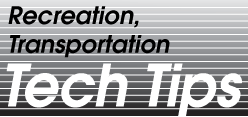 |
 |
Technology & Development Center |
| October 2006 | 2300 | 7700 | 0623-2340-MTDC |
James "Scott" Groenier, Project Leader
The Missoula Technology and Development Center (MTDC) has reviewed available gate designs from around the world that allow wheelchair access, but restrict all-terrain vehicles (ATVs), motorcycles, and mountain bikes. We also searched for an existing gate or gate design that would allow access by wheelchairs and horses, but keep out ATVs and motorcycles.

Figure 1. Accessible Timber Kissing Gate
for Wheelchair Accessibility
click image for technical drawing
When the Forest Service installs a gate, berm, or other type of device to restrict motor vehicles on a road or trail, but encourages foot travel beyond the restriction, a passage 32 inches wide must be provided for someone using a wheelchair (Section 504 of the Rehabilitation Act of 1973).
Web sites with designs that allow wheelchair access while restricting access by ATVs and motorcycles are listed near the end of this tech tip. The best Web site was that of Scottish Natural Heritage, an organization in the United Kingdom (UK). They have a series of drawings for gate designs that meet accessibility requirements in the UK.
The Scottish Natural Heritage gates are smaller than those required for accessibility in the United States. We increased the opening dimensions to meet Federal requirements in the United States. The timber kissing gate (figure 1) and the chicane (figure 2) have been modified to meet the Federal requirements. In addition, a modified kissing gate design was developed to be used for existing fence openings (figure 3).

Figure 2. Chicane
for Wheelchair Accessibility
click image for technical drawing

Figure 3. Timber Kissing Gate—Modification for
Existing
Fence Opening
for Wheelchair Accessibility
click image for technical drawing
Another concern was finding a way to allow horse and pedestrian access, while restricting ATVs and motorcycles. Two types of structures that will allow horse access, but restrict ATVs, are the "V" gates used at the Ashley National Forest (figures 4 and 5) and at the Lolo National Forest (figure 6).

Figure 4. A horse walking through a "V" gate in Utah.
This gate
is not accessible because it is narrower
than the minimum width required for
passage
of a
wheelchair
(32 inches) and the bar across
the opening is higher than 1 inch.

Figure 5. "V" Horse Gate
with Wheelchair Accessibility
click image for technical drawing
The bottom log should be removed from the gate shown in figure 6 because the log could be a tripping hazard and it prevents wheelchair access. A horse stile restricts ATVs and motorcycles and discourages mountain bikes, while allowing passage by horses (figure 7).

Figure 6—A gate in the Lolo National Forest that allows
horses to pass,
but restricts ATVs. This gate is not
accessible
because it is narrower than
the minimum width
required for passage of a wheelchair (32 inches) and
the
bar across the opening is higher than 1 inch.

Figure 7—A horse stile. This gate is not accessible because
the bars
across the opening are higher than 1 inch.
- continue -
The Forest Service, United States Department of Agriculture (USDA), has developed this information for the guidance of its employees, its contractors, and its cooperating Federal and State agencies, and is not responsible for the interpretation or use of this information by anyone except its own employees. The use of trade, firm, or corporation names in this document is for the information and convenience of the reader, and does not constitute an endorsement by the Department of any product or service to the exclusion of others that may be suitable. The U.S. Department of Agriculture (USDA) prohibits discrimination in all its programs and activities on the basis of race, color, national origin, age, disability, and where applicable, sex, marital status, familial status, parental status, religion, sexual orientation, genetic information, political beliefs, reprisal, or because all or part of an individual’s income is derived from any public assistance program. (Not all prohibited bases apply to all programs.) Persons with disabilities who require alternative means for communication of program information (Braille, large print, audiotape, etc.) should contact USDA’s TARGET Center at (202) 720-2600 (voice and TDD). To file a complaint of discrimination, write to USDA, Director, Office of Civil Rights, 1400 Independence Avenue, S.W., Washington, D.C. 20250-9410, or call (800) 795-3272 (voice) or (202) 720-6382 (TDD). USDA is an equal opportunity provider and employer. |
|
Next Top |